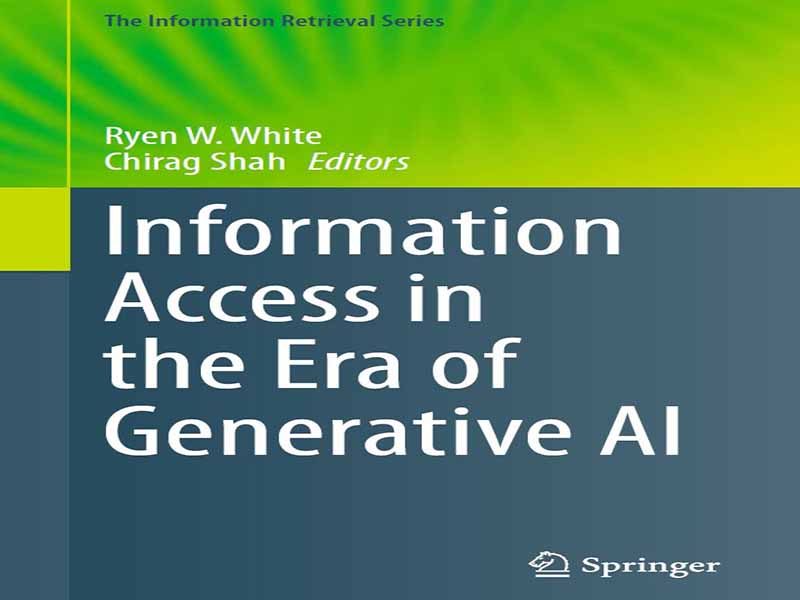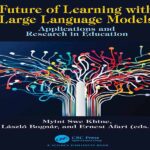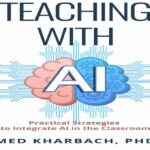- عنوان کتاب: Information Access in the Era of Generative AI
- نویسنده: ChengXiang Zhai
- حوزه: هوش مصنوعی مولد
- سال انتشار: 2025
- تعداد صفحه: 250
- زبان اصلی: انگلیسی
- نوع فایل: pdf
- حجم فایل: 3.01 مگابایت
مقدمه در سالهای اخیر، هوش مصنوعی مولد (GenAI) به عنوان یک فناوری پیشگام ظهور کرده است که نوید تحول در بسیاری از صنایع و زندگی شخصی و حرفهای افراد را میدهد. این کتاب GenAI و نقش آن در دسترسی به اطلاعات، یا به طور گسترده تر، تعامل اطلاعات، هم اکنون و هم برای دهه های آینده را مورد بحث قرار می دهد. به خوبی شناخته شده است که اطلاعات مایه حیات تصمیم گیری و اقدام است و توانایی کمک به افراد در یافتن، درک و استفاده از اطلاعات، اصل اصلی کمک به آنها برای رسیدن به اهدافشان است. تقاطع GenAI و دسترسی به اطلاعات اغلب به عنوان بازیابی اطلاعات تولیدی (GenIR) شناخته می شود. ما از “GenAI” و “GenIR” و انواع آنها، در صورت لزوم، در سراسر کتاب، بسته به زمینه، استفاده می کنیم. این کتاب برای دانشجویان فارغ التحصیل و همچنین دانشجویان کارشناسی ارشد و محققین علاقه مند به مسائل بازیابی اطلاعات، دسترسی، و تعاملات و همچنین کاربردهای GenAI در زمینه های مختلف اطلاعاتی هدف قرار گرفته است. در حالی که برخی از بخشها پیشزمینه قبلی در IR یا AI را در نظر میگیرند، بسیاری دیگر چنین نیستند، و این کتاب را برای پذیرش در کلاسهای مختلف بهعنوان منبع اولیه یا بهعنوان ماده مکمل برای طیف گستردهای از برنامههای درسی و برنامههای آموزشی مناسب میسازد. نقش GenAI در دسترسی به اطلاعات پیچیده و پویا و دارای ابعاد متعدد است. برای پرداختن به این موضوع، پس از معرفی مختصر خود به GenAI و GenIR (فصل 1)، ما باقیمانده کتاب را به هشت فصل تقسیم میکنیم که هر کدام ابعاد یا موضوع فرعی متفاوتی را هدف قرار میدهند. در ادامه فصول با جزئیات بیشتر توضیح داده شده است. هر فصل توسط متخصصان موضوع در این زمینه نوشته شده است و عمیقاً به بعد در دست می پردازد و یک نمای کلی، خلاصه ای از آخرین پیشرفت ها در آن زمینه و مسیری رو به جلو ارائه می دهد. فصل 2: مبانی بازیابی اطلاعات تولیدی – این فصل که توسط Qingyao Ai، Jingtao Zhan و Yiqun Liu تألیف شده است، به اصول اصلی GenIR می پردازد، به بررسی ترکیب نتایج، اعتبار سنجی و فرآیندهای اسناد، پدیده توهم در مدل های زبان بزرگ (LLMs) و چند رسانه ای و چند رسانه ای می پردازد. LLMs، بازیابی-افزایش نسل (RAG)، و درک بدنه. فصل 3: تعامل با سیستمهای بازیابی اطلاعات تولیدی – تالیف محمد علیان نژادیم جاک گویزدکا و حامد زمانی، این فصل به بررسی پویایی تعامل کاربر با سیستمهای GenIR میپردازد. درک هدف، هنر پرس و جو، ایجاد تجربیات جدید، پیچیدگی های سیستم های مکالمه، نقش آژانس و اتوماسیون، مهارت مهندسی سریع و اهمیت توضیحات را پوشش می دهد. فصل 4: تطبیق سیستمهای بازیابی اطلاعات تولیدی با کاربران، وظایف و سناریوها – یوهان تریپاس، دامیانو اسپینا و فالک اسکولر در مورد تحقیق در مورد تطبیق سیستمهای GenIR برای متناسب کردن کاربران، وظایف خاص و سناریوهای متنوع بحث میکنند. این فصل شخصیسازی، تخصصیسازی، استنتاج ترکیبی و درک وظیفه را پوشش میدهد که منعکسکننده سازگاری سیستمهای GenIR است. فصل 5: بهبود سیستم های بازیابی اطلاعات تولیدی بر اساس بازخورد کاربر – Qingyao Ai، Zhicheng Dou و Min Zhang سکان هدایت این فصل را بر عهده می گیرند و بر بهبود تکراری سیستم های GenIR از طریق بازخورد کاربر تمرکز می کنند. هم ترازی، ادغام انسان ها در حلقه، یادگیری مستمر، یادگیری تقویتی از بازخورد انسانی (RLHF) و تفاوت های ظریف بازخورد ضمنی و صریح را بررسی می کند. فصل 6: ارزیابی بازیابی اطلاعات تولیدی – مروه علاوفی، نگار عرب زاده، چارلز کلارک، و مارک ساندرسون یک مرور کلی از معیارهای ارزیابی، روششناسی، و اهمیت تکرارپذیری در سیستمهای GenIR ارائه میدهند. آنها همچنین ارتباط با چارچوب های ارزیابی بنیادی IR مانند کرانفیلد و TREC را بررسی می کنند. فصل 7: پیامدهای اجتماعی-تکنیکی هوش مصنوعی مولد برای دسترسی به اطلاعات – بهسکار میترا، هنریت کرامر، و اولیا گورویچ مفاهیم اجتماعی GenIR را مورد بحث قرار میدهند. آنها مروری بر خطرات سیستمیک ناشی از استفاده از GenAI در IR (به عنوان مثال، تأثیر منفی اکوسیستم اطلاعات، ایمنی و دینامیک قدرت)، تأثیر روشهای ارزیابی و مشوقهای اکوسیستم در مورد سوء استفاده را ارائه میدهند. فصل 8: توصیه در عصر هوش مصنوعی مولد – ونجی وانگ، یونگ فنگ ژانگ و تات-سنگ چوا قلمرو توصیهها را در GenIR بررسی میکنند. آنها به سیستم های توصیه گر، توصیه های شخصی سازی شده، توصیه های قابل توضیح و ادغام LLM با سیستم های توصیه می پردازند. فصل 9: طراحی برای آینده دسترسی به اطلاعات با بازیابی اطلاعات تولیدی – ونسا مرداک، چیا جونگ لی و ویلیام هرش آینده دسترسی به اطلاعات را از طریق لنز GenIR تصور می کنند. آنها تجربیات جدیدی مانند دسترسی فعال به اطلاعات، مدل های کسب و کار در حال ظهور، برنامه های کاربردی فراتر از بازیابی اطلاعات سنتی، فراگیر بودن GenIR و کاربرد آن را مورد بحث قرار می دهند.
Preface In recent years, Generative Artificial Intelligence (GenAI) has emerged as a groundbreaking technology that promises to revolutionize many industries and people’s personal and professional lives. This book discusses GenAI and its role in information access, or more broadly, information interaction, both now and for decades to come. It is well known that information is the lifeblood of decision- making and action, and being able to help people find, understand, and use information is a central tenet of helping them attain their goals. The intersection of GenAI and information access is often referred to as Generative Information Retrieval (GenIR). We use “GenAI” and “GenIR”, and variants thereof, where appropriate throughout the book, depending on the context. The book is targeted to graduate students as well as advanced undergraduates and researchers interested in issues of information retrieval, access, and interactions, as well as applications of GenAI in various informational contexts. While some of the parts assume prior background in IR or AI, most others do not, making this book suitable for adoption in various classes as a primary source or as a supplementary material for a wide variety of curricula and training programs. The role of GenAI in information access is complex and dynamic, with many dimensions. To address this, following our brief introduction to GenAI and GenIR (Chap. 1), we divide the remainder of the book into eight chapters, each targeting a different dimension or sub-topic. The chapters are described in more detail below. Each chapter is written by subject matter experts in the field and dives deep into the dimension at hand, presenting a general overview, a summary of the latest advances in that area, and a path forward. Chapter 2: Foundations of Generative Information Retrieval—This chapter, authored by Qingyao Ai, Jingtao Zhan, and Yiqun Liu, delves into the core principles of GenIR, exploring the synthesis of results, validation and attribution processes, the phenomenon of hallucination in Large Language Models (LLMs), and the expansion beyond text to include multimedia and multimodal interactions with LLMs, Retrieval-Augmented Generation (RAG), and corpus understanding. Chapter 3: Interactions with Generative Information Retrieval Systems— Authored by Mohammad Aliannejadim Jacek Gwizdka and Hamed Zamani, this chapter investigates the dynamics of user engagement with GenIR systems. It covers intent understanding, the art of querying, crafting new experiences, the intricacies of conversational systems, the role of agency and automation, the craft of prompt engineering, and the importance of explanations. Chapter 4: Adapting Generative Information Retrieval Systems to Users, Tasks, and Scenarios—Johanne Trippas, Damiano Spina, and Falk Scholer dis- cuss research on tailoring GenIR systems to fit individual users, specific tasks, and diverse scenarios. The chapter covers personalization, specialization, hybrid inference, and task understanding, reflecting the adaptability of GenIR systems. Chapter 5: Improving Generative Information Retrieval Systems Based on User Feedback—Qingyao Ai, Zhicheng Dou, and Min Zhang take the helm in this chapter, focusing on the iterative improvement of GenIR systems through user feedback. It examines alignment, the integration of humans in the loop, continual learning, Reinforcement Learning from Human Feedback (RLHF), and the nuances of implicit and explicit feedback. Chapter 6: Generative Information Retrieval Evaluation—Marwah Alaofi, Negar Arabzadeh, Charles Clarke, and Mark Sanderson provide a comprehensive overview of the evaluation metrics, methodologies, and the importance of repro- ducibility in GenIR systems. They also explore the connection to foundational IR evaluation frameworks such as Cranfield and TREC. Chapter 7: Sociotechnical Implications of Generative Artificial Intelligence for Information Access—Bhaskar Mitra, Henriette Cramer, and Olya Gurevich discuss the societal implications of GenIR. They present an overview of systemic risks from the usage of GenAI in IR (e.g., negative information ecosystem impact, safety, and power dynamics), impact of evaluation methods, and ecosystem incen- tives around misuse. Chapter 8: Recommendation in the Era of Generative Artificial Intelli- gence—Wenjie Wang, Yongfeng Zhang, and Tat-Seng Chua explore the realm of recommendations within GenIR. They delve into recommender systems, personal- ized recommendations, explainable recommendations, and the integration of LLMs with recommendation systems. Chapter 9: Designing for the Future of Information Access with Generative Information Retrieval—Vanessa Murdock, Chia-Jung Lee, and William Hersh envision the future of information access through the lens of GenIR. They discuss new experiences such as proactive information access, emerging business models, applications beyond traditional information retrieval, the ubiquity of GenIR, and its application in specialized domains such as healthcare. These chapter brief summaries provide a glimpse into the comprehensive cover- age of GenIR topics that the book will offer. Each chapter promises to contribute valuable insights into the rapidly evolving field of GenAI, and GenIR in particular.
این کتاب را میتوانید از لینک زیر بصورت رایگان دانلود کنید:




































نظرات کاربران